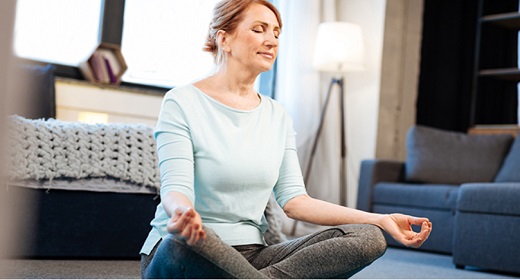by Lena Schmidt: Have you ever cringed upon hearing the words, “Please find a comfortable seat”?
These few words, often uttered at the start of a guided group meditation or group yoga class can trigger the desire to run right out of the room. That may be because, for you, seated meditation causes a great feeling of discomfort. A comfortable seat? A comfortable seat? These words may seem impossible together!
Perhaps you have seen images of (seemingly) blissful meditators practically levitating from their cushions. Perhaps you are genuinely interested in meditation but your knees scream at you while you attempt to quiet your mind? Or is it your back muscles that speak (shout?) to you? It could be that you enjoy meditating but wish you could simply find a more satisfying and sustainable way to sit.
Luckily, there are just about as many postures for meditating as there are ways to meditate. Read on for more tips and suggestions and everything you need to know about meditative postures.
Meditation 101
First, a few words on meditation itself. If you are not already convinced it is worth trying meditation, finding the perfect posture for your body may persuade you. Finding a meditative posture that is right for your body can make all the difference.
There are many different styles of meditation. According to Yoga International, “Meditation is a precise technique for resting the mind and attaining a state of consciousness that is totally different from the normal waking state. It is the means for fathoming all the levels of ourselves and finally experiencing the center of consciousness within. Meditation is not a part of any religion; it is a science . . . In meditation, the mind is clear, relaxed, and inwardly focused. When you meditate, you are fully awake and alert, but your mind is not focused on the external world or on the events taking place around you.”
Benefits of regular meditation practice, whether seated or otherwise, may include the following:
- Pain management
- Reduced anxiety
- Increased self-awareness
- Improved sleep
- Better stress-management skills
- Headache relief
- Reduced negative emotions
Since a regular meditation practice is so beneficial for your body, mind, heart, and spirit, it behooves you to find ways to practice that are sustainable. Meditation can be practiced seated, reclining, walking, solo, in a group, guided, or in silence. So, although you may choose to sit for 20 minutes with your spine erect and hands placed in an intentional mudra just so, then again, you may not. Meditation could include:
- Painting
- Listening to music
- Dancing
- Doing the dishes
- Sitting quietly
- Doing anything that helps you be present and relax
If you do choose to practice seated meditation, you may not always be comfortable during your meditation session (that is indeed part of the practice experience . . . more on that later), it is worth exploring several postures in order to find the one best suited for your body.
Variations on Meditative Postures
You may like to try out a few variations of postures for meditating—seated in a chair, seated on a cushion with your legs crossed, kneeling on your heels, or with your legs arranged in a creative manner that has never been tried before! Meditative postures will look different for everyone.
Some traditions and lineages encourage one posture for all practitioners. For example, in Zen Buddhist meditation, zazen, practitioners are encouraged to sit in a full- or half-lotus position (comfortable for their flexibility) with their eyes slightly open looking three feet in front of them on the floor. Their hands rest gently, one on top of the other, with the thumbs close enough to hold a piece of paper between them (Cosmic Mudra). Their spine and neck are as straight as possible.
In Vipassana meditation, teachers will encourage you to sit comfortably yet upright, whether in a chair, on a bench, or on cushions. Meditations are generally in silence, with little instruction given to practitioners who commit to sitting for retreats, taking place for a day, a weekend, 10 days at a time, or even longer.
In Zen walking meditation, kinhin, meditation practitioners walk slowly and mindfully. The hands are placed so that one hand makes a fist with the thumb tucked inside, the right-hand covers the left hand, the shoulders are relaxed, the lower abdomen is relaxed, the neck is relaxed, the chin is tucked in, and the gaze is lowered. Practitioners walk slowly in pace with their breath.
The purpose behind an erect spine, simple seat, focused eyes, and purposeful hands in any meditation style is to keep you alert, awake, and disciplined.
Use props for More Comfortable Meditative Postures
Chairs, cushions, wooden benches, blankets, yoga blocks, rolled-up clothing, and other improvised props can help make your seat meditation posture more satisfying. Props can help make your meditation more comfortable and sustainable. Setting up your props can also be part of your personal ritual of preparing for meditation.
You can place a rolled-up blanket over your feet to keep them warm. You can place a scarf or head cover over your head during meditation for warmth or tradition, as in the Kundalini yoga and meditation tradition.
Prepare yourself to sit by arranging your props, setting out your altar or any sacred items in front of you, and creating the ideal conditions for calm (such as a quiet, semi-dark, and comfortably warm place, if possible).
Warm-Up Poses
It may be beneficial to prepare yourself physically to sit more comfortably, however you choose to practice meditation. Here are some yoga-inspired physical warm-ups you may like to try before you sit in any of the below-suggested meditation postures.
These movements can be done in any order, so find the flow that makes the most sense for you. You may find that you prefer to practice these poses and stretches before you meditate or you may find that your body feels the need for movement after a deep meditation session. Or do them before and after! Either way, these postures will help prepare the hips, ankles, low back, mid-back, and neck for a more comfortable meditation experience.
1. Cow and Cat Pose


- Come down to hands and knees.
- Inhale and arch your back, tilt your tailbone up, and broaden your collar bones.
- Exhale and round your back, tilt your tailbone down, and tilt your chin to your chest.
- Repeat for 30 seconds to one minute.
2. Torso Circles

- Sit with your legs crossed loosely at your ankles.
- Bring one hand to each knee.
- Begin to circle your torso in one direction around and around for 30 seconds to one minute. Allow your shoulders and head to move freely.
- Switch the cross of your legs and circle the other direction.
3. Side Bends
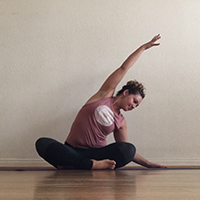
- Sit with your legs crossed loosely at your ankles.
- Inhale and reach your arms up.
- Exhale and place your left hand to the ground and reach your right arm overhead.
- Inhale and reach your arms up.
- Exhale and place your right hand to the ground and reach your left arm overhead.
- Repeat side to side for 30 seconds to one minute.
4. Feet and Ankle Circles
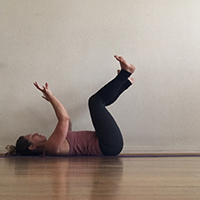
- Recline onto your back.
- Extend your legs up above you with legs bent or straight.
- Circle your ankles three times in each direction.
- Flex and point your feet several times.
- Flare your toes and curl your toes 10 times.
- Shake your legs and feet and bring your legs back down.
5. Gentle Twist
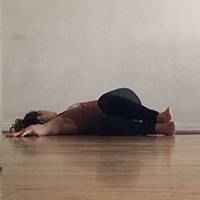
- Recline onto your back.
- Hug your knees into your chest and extend your arms out to the side.
- Tip your knees to one side and breathe deeply for 30 seconds to one minute.
- Roll your knees to the other side and repeat.
Seated Meditation Postures
The following are several common meditation postures for seated meditation. Try committing to one posture for a week and then trying out another. You may find one that suits you right away or you may adjust according to your body’s changing needs.
1. Sit on a Cushion
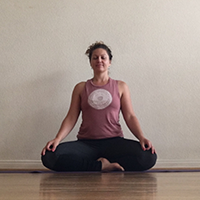
You can sit on a Zafu, a bolster, or a stack of neatly folded blankets. You can sit up straight or lean your back against a wall.
- Sit with your legs crossed in easy sitting pose, half-lotus, full lotus, or with your legs comfortably extended.
- Sit with your buttocks on the edge of the prop and let the flesh of your buttocks rollback.
- Tilt your knees down and lengthen your spine. Having your hips elevated on the cushion allows your pelvis to roll slightly forward, which creates more comfort for the low back and spine in this position.
- Wrap a blanket around your feet and under your ankles for comfort and warmth.
- Switch the cross of your legs at any point during your practice.
2. Sit in a Chair

You can sit in any kind of chair that is comfortable for you.
- Sit with a tall spine or lean back gently against the chair back without slumping. If it is a really soft chair, then you may need to work harder to sit up straight.
- Use a cushion or blanket on the seat or chair back for sustained comfort.
- Place yoga blocks or a stack of blankets beneath your feet if they do not touch the floor; this way your knees are almost in line with your waist so that your hip flexors don’t have to work too hard.
3. Kneel on Your Heels
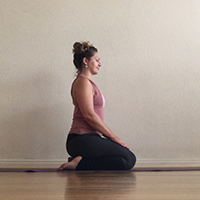
- If your knee and ankle flexibility allows, sit back on your heels with your shins on the ground.
- Place a blanket beneath your knees and ankles for sustained meditation.
- For more support, sit on a wooden meditation stool, a yoga block, or roll a blanket between your calves and hamstrings.
4. Recline
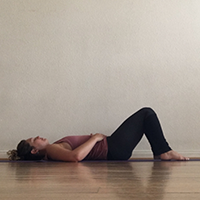
If no sitting position is comfortable for you, recline on your back for your meditation.
- Place a blanket under your head and a blanket under your low back for soft cushioning.
- If you are worried about falling asleep during meditation (and don’t want to or are not intending to), try propping yourself up with yoga blocks or bolsters so you are at a slight incline.
- Yoga nidra is an enjoyable meditative practice with many benefits, so if you are looking for a lying meditation practice to take you directly into sleep, give that one a try.
However you choose to practice, do it! Get out your cushion or chair. Put on a guided meditation or sit in silence. Set a timer to stay within a time boundary or let yourself sit as long as you want. Sit how you have always sat or try a new way of folding your legs today. Try out several different meditation styles and find the perfect posture to tailor your practice to your personal needs (and knees!) and intentions. And as long-time meditation teacher Pema Chodron shares, practice meditation with gentleness, patience, and humor. Happy meditating!







